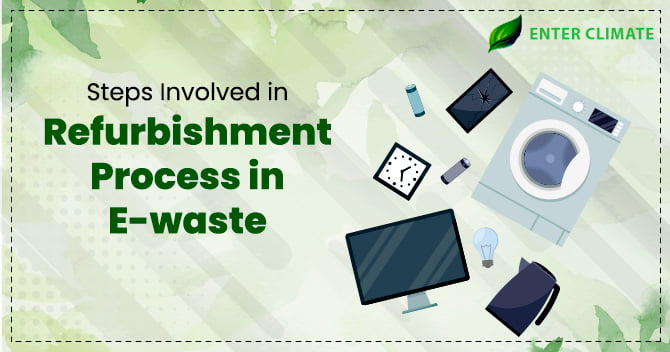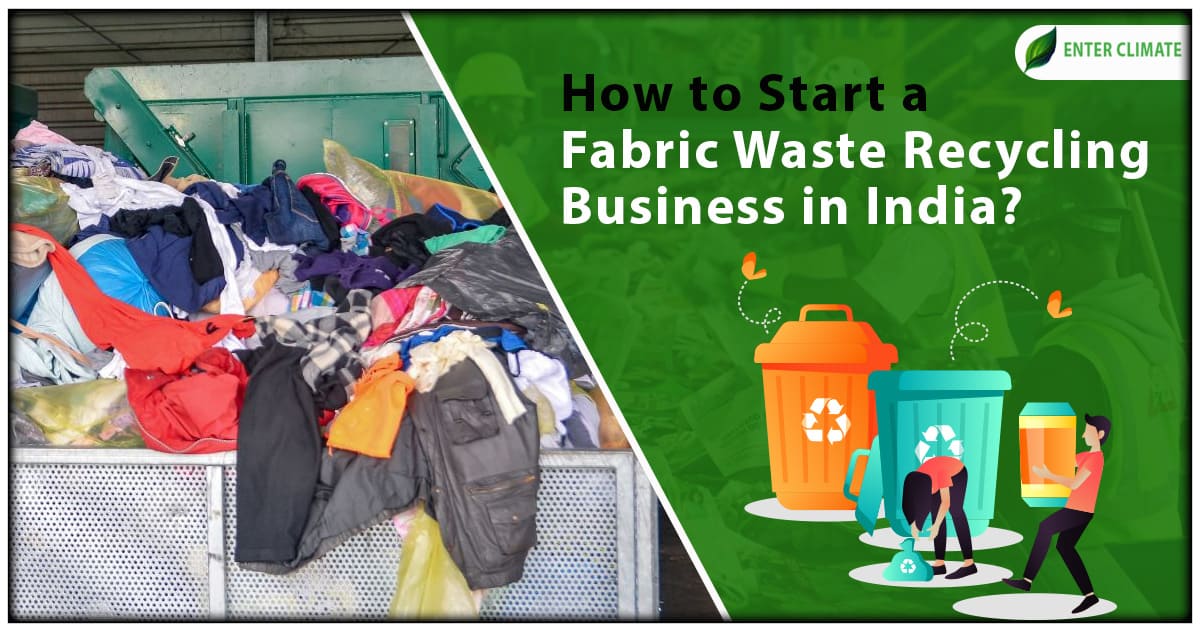Steps Involved in Refurbishment Process in E-waste: An Overview
 30 Jul, 2022
30 Jul, 2022 
To understand the steps involved in the refurbishment process in the e-waste business, one must first have a clear idea of what refurbishment is. Refurbishment can involve one or all of the following activities, i.e.repair, upgrade, cleaning and even enhancement up to some extent. Refurbishment can be defined as bringing used e-waste up to a certain pre-determined quality and standard. Refurbishment may involve replacing worn and critical parts and aesthetically making the EEE look new. The level of refurbishment and cosmetic update depends on various factors, such as the manufacturer’s and the industry’s standards, asset type and the availability of non-proprietary equipment-specific technologies in the market. The refurbishment process in e-waste can be in the form of improvement to functionality, correcting malfunction and providing cosmetic upgrades. Data provided by some Indian refurbishers suggest that the value of the refurbished electronics goods market reached a value of $5 billion in March 2021. Moreover, the market has the potential to grow even further, i.e.upto $11 billion in gross value by March 2026, and the organised sellers are expected to account for 20% of the market of Total EEE sold.
Source of Refurbished Electronics
E-waste in India is present in abundance. Most e-waste is discarded because of minor faults, decreased performance, or software or hardware obsolescence and can be brought into the consumer market after refurbishment at a fraction of the price needed to buy a new replacement. But the refurbishment process in e-waste requires sourcing the discarded and semi-functional e-waste that meets a minimum performance quality and condition. Few such sources have been discussed below.
Asset Recovery of IT businesses: Many organisations need to liquidate, resell or redeploy their assets for various reasons. In such cases, they need the assistance of refurbishers who are experts in retrieving most of the value from their e-waste through refurbishment. By selling such assets to refurbishers, the organisations also gain a decent return on their investment rather than selling it as e-waste.
Through OEMs and retailers – Often, newly manufactured products reach the retailer in a non-working or defective condition due to improper handling during transit or any other reason. These products are referred to as ‘dead-on-arrival stock’. Such products are shipped back to the original equipment manufacturer (OEM), where it is repaired and re-distributed in the secondary market.
Through Individuals – Individual consumers return new EEE in the warranty period to the seller or a licensed refurbisher in case of any fault in the product or when they are not satisfied with the device’s performance. An authorised refurbisher can source these products through OEMs and retailers and sell them as ‘refurbished items’ after conducting the necessary refurbishment process in e-waste sourced from individual or bulk consumers.
Through E-waste Auction: many public and private organisations wanting to upgrade their IT infrastructure usually sell their e-waste through auctions either online through the traditional methods. These platforms are one of the best ways to source cheap and quality e-waste.
Steps involved in the Refurbishment process in E-Waste
- Initial analysis of the product: The first step for refurbishing e-waste should be analysing the extent of work needed to get the product upto the desired working standard. Prior inspection of the e-waste will give an idea of the time and cost involved. This check will also help triage or prioritise the refurbishment process later on. If the refurbisher is convinced that the refurbishment process in e-waste in front of him will be profitable, he can proceed with the subsequent steps.
- Sanitisation: The sanitation process involves cleaning the e-waste’s outer surface to remove any marks, stickers or dust. Similarly, the inside of the e-waste must also be cleaned of dust, dirt and unwanted substances manually or through blowers, cleaning agents etc.
- Data Wipe: Most e-wastes that have installed memory like laptops, desktops, smartphones, etc., may have pre-existing data of the previous owner that must be wiped off. A factory reset during the refurbishment process in e-waste ensures smooth functioning of the EEE and also resolves any technical issues arising from corrupt data in the memory.
- Repair/ Replacement: the issues identified in the initial stage of inspection must be addressed at this stage. All non-functional components must be repaired or replaced, considering the cost incurred in the process. If the cost of purchasing and repairing the product exceeds the product’s price in the refurbished market, repairing must be avoided.
- Testing: Stringent quality tests and controls must be ensured to check the product. Proper testing helps in guaranteeing product performance in the form of warranty and after-sale services. It also helps build trust between the consumers and the refurbisher. Each functionality must be thoroughly tested before clearing it fit.
- Cosmetic/ software enhancement: The product is carefully reassembled after testing. Now, if the product can be made more appealing by making any cosmetic and software upgrades, such actions can also be done during the refurbishment process in e-waste. It is vital to make refurbished EEE look and feel like ‘new’ and not just perform like ‘new’.
Procedure for Authorisation for Refurbisher
The refurbisher must apply for a one-time authorisation by the CPCB after getting all prerequisites registration. The documents needed for the authorisation process include
- Duly filled Form 1(a)
- CTE under Air and Water Act[1]
- Certificate of Registration(issued by DIC or any authorised entity)
- Proof of Installed capacity of the facility.
Requirement for Refurbishers
CPCB and SPCBsissue important guidelines for the refurbishment process in e-waste from time to time. Certain infrastructural requirements and adherence to post-compliance are issued at the time of authorisation by the Board. But keeping track of industry updates and performing such additional tasks can be challenging for refurbishers. Proper guidance by industry experts can save them a lot of time and resources during the registration and authorisation process.
Infrastructural Requirements for Refurbishment Business
The refurbisher must ensure minimum premise requirements for their refurbishment facility, like waterproofing of roofs and impermeable surfaces. Certain space requirement has also been given as guidelines for the refurbishment process in e-waste. As a general rule, refurbishers with a capacity of 1 Ton per day will require a minimum of 150 square meter area for refurbishing, temporary storage of e-waste generated and space for refurbished EEE. The refurbishing area should be properly vented and have dust control equipment. De-dusting system, necessary personal protective equipment and measures for collecting discards like coolants, refrigerant gases and compressor oils used in EEE should be provided.
Responsibilities of Refurbishers in Refurbishment process in E-Waste
- To collect e-waste generated during refurbishing.
- Channelise the waste to authorised recyclers or dismantlers through its collection centres
- Apply for one-time authorisation with the concerned SPCB
- To ensure no damage is caused to the environment during the storage and transportation of e-waste.
- To ensure that the refurbishing process does not adversely affect human health and the environment.
- To file annual returns in Form-3 to the concerned SPCB on or before the 30th day of June every year.
- To maintain the records of the e-waste handled in Form-2 and produce it for scrutiny.
Conclusion
Brand new products are often in short supply due to issues like disruption in the supply chain or when demand surpasses the supply of the product. Refurbished EEE are gradually filling up this demand. Refurbished EEE also have an innate advantage- they are cheaper. Consumers are increasingly getting aware of the availability of quality EEE at lucrative prices through social media and online advertising. Can a refurbished product check all the benefits that come with a brand new EEE? Well, certainly not. But refurbishment can be as beneficial as recycling for a developing economy like India. Resources are limited, and a free run in manufacturing will not be sustainable for long, even if possible. Refurbishment businesses will indirectly aid in developing a resource-efficient manufacturing process in the circular economy, which is in focus nowadays and help the environment too by optimally utilising the full life of products. But to harvest the full potential of the refurbishing sector, the refurbishment process in e-waste will need a boost. The responsibility to develop trust in refurbished products lies with the refurbisher but can be aided by the government or reputable organisations in the form of certification, which will assure the customer of the quality. Also, refurbished EEEcan be marked with ratings (or grading) based on the level of refurbishment performed or the cosmetic enhancements. The refurbishment process of e-waste is more than a business opportunity. By keeping e-waste, reprocessed EEE products, or its materials in a closed-loop supply chain as long as possible, the use of raw material, energy and emissions can all be significantly reduced, thereby reducing the overall refurbishment cost.
Read our Article:Authorisation Requirements for E-Waste Dismantlers in India













